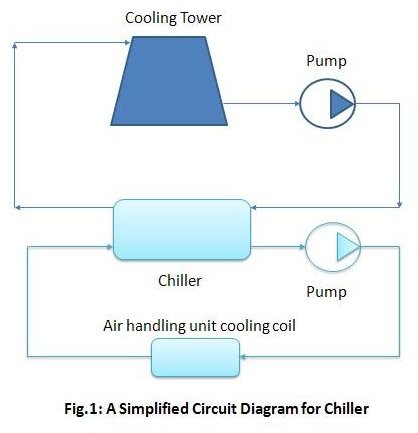Chiller Water Treatments – the Why and How of Closed Loop Chilled Water Treatment Systems
Chiller Water Circuit
The above picture is showing the chiller circuit in simplified form. All the lines are either carrying either cold water or chilled water.
Both the water circuits are closed in nature; hence the justification for chiller water treatments is often questioned. People who question this cite examples of many chiller plants running well for years without using water treatment. My opinion, after researching the subject, is that, yes, you should use treatment for closed loop chilled water system in most cases. You can probably ignore the water treatment where the tubing and valves are made up of stainless steel, where the heat exchangers are made of titanium, and also where pure RO water is used for topping up the system.
Available Water Treatment Methods
Although chemical dosing is the most widely used method, to make the chemical treatment effective, it is recommended that more than one of the following methods should be used simultaneously in order to obtain the maximum benefits:
- Chemical treatment (or dosing): Proprietary (like NALCOOL) or generic chemicals (like Sodium Silicate, Sodium Nitrite, and Sodium Sulfite) compositions are used to prevent the chiller system from corrosion, scaling, fouling and microbiological growth. How? Mainly in three ways: first, these chemicals react with the pipes to form a protective thin inside layer; second, the chemicals help in maintaining the pH level; and third, the chemicals remove corrosive dissolved oxygen in the water. Dosing pumps are used for applying the predetermined quantities of chemicals at regular intervals.
- Mechanical Treatment: Before commissioning, the whole system should be cleaned and flushed using treated water and commission it as soon as possible. Attend all the leaking points regularly.
- Filtration: The filter is used for removing (or at least reducing) the solid particles (like welding flush, concrete particles, etc.).
- UV and Ozone treatment: This method is effective for preventing the microbiological growth in the system, but is not used widely for chillers unless there is some restriction for chemical treatment. Unlike chemical dosing, this treatment does not generate harmful chemical by-products.
Saving Costs with Chiller Water Treatment
Chiller water treatments should be a must for most chiller plants… where the pipes are made up low carbon steel and normal water is used as the make-up water. Statistics say that for a 1,000 ton chiller, a whopping $15,000 (approx.) saving on the energy bill is possible by opting for an appropriate water treatment program. I want to emphasis the words “appropriate treatment” especially for the chemical dosing, because otherwise, the by-product from the chemical reactions can adverse the quality of the water. For example, the higher concentration (900-1200 PPM) of the Sodium Nitrite (NaNO2) increases the mechanical seal and valve corrosion.
So, the final words: use water treatments of the chillers appropriately and save $$$.
References
